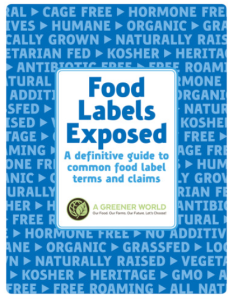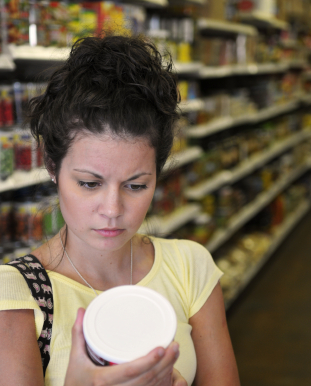What exactly do all these terms and claims really mean, and how do you know which ones are trustworthy?
by Callie Casteel, Animal Welfare Approved certifies and supports independent family farmers raising their animals to the highest animal welfare standards, outdoors on pasture and range. AWA is a program of A Greener World.
In general, unless the claim is being checked by an independent third party, the integrity of a food label is only as reliable as the individual or company making it. As a shopper, understanding what label claims mean—and don’t mean—will help ensure your expectations are met (and as a producer, that your products are appropriately valued).To help people make informed decisions about certification and food purchasing, Animal Welfare Approved (AWA) and our parent organization, the nonprofit certifier A Greener World (AGW), created Food Labels Exposed, a free guide to the most commonly used label claims (see below). Here are just a few examples:
ORGANIC/CERTIFIED ORGANIC is a verified claim with a legal definition. All products sold as organic must meet the United States Department of Agriculture (USDA) National Organic Program standards. In general, organic production limits the use of chemicals, pesticides, hormones, antibiotics and other inputs. However, it fares poorly when it comes to animal welfare, and does not strictly define production practices related to space per animal or outdoor access.
NOTE: USDA released final rules mandating stronger animal welfare standards for certified organic livestock farmers in 2016, but there are significant questions about when (or even whether) these rules will be implemented. Some of the specific provisions, include: Prohibits physical alterations that cause stress in livestock; Provides minimum indoor and outdoor space requirements for poultry; Redefines “outdoors” to exclude porches, covered areas attached to the poultry house and Offers specific standards for humane treatment during transport and slaughter. You can read the full rules here.
GRASS FED is legally defined by the USDA Food Safety and Inspection Service (FSIS), but actual production practices can vary greatly. Consumers should be wary of any grass fed label claim NOT verified by a trusted third-party certification. What’s more, unless it’s accompanied by an additional certification, a grass fed label refers only to the animals’ diet: It does not tell you if an animal was given routine antibiotics or hormones, or offer any other assurances about animal welfare or the environment. Although all grass fed label claims require official FSIS approval before use, a signed statement (affidavit) from the farmer is typically considered “sufficient documentation”—meaning many farms are never even audited. Certified Grassfed by AGW is the only label to guarantee animals are 100 percent grass fed for life and managed according to high welfare standards, outdoors on pasture or range, with annual farm audits.
CFSA is on a mission to bring local, organic food to your table from a farmer who shares your values. Join us!
PASTURED/PASTURE-RAISED is one of many label claims that do not have a legal or regulated definition. While it implies animals were raised outdoors on pasture, there is no way to know—unless it’s accompanied by a third-party certification that requires pasture-based management, such as Animal Welfare Approved. The perceived value of the pasture-raised claim makes it ripe for greenwashing by unscrupulous food manufacturers.
Without third-party verification to high-welfare standards or visiting the farm in person (and having the agricultural expertise to evaluate it), you’re probably still buying industrially raised products.
CAGE-FREE also has no legal or regulated definition. While it implies animals are raised outdoors on pasture, this claim is highly misleading: “Cage-free” chickens, for example, are often raised indoors in overcrowded, enclosed barns.
NATURAL/ALL NATURAL is one of the most misleading label claims. Consumer surveys show most people think it refers to how animals are raised. Yet a “natural” label has nothing to do with how animals are raised. As legally defined by the USDA, it applies only to how meat is processed after slaughter.
NO ANTIBIOTICS ADDED (for red meat and poultry) is legally defined by the USDA FSIS and used on labels for meat or poultry products on an affidavit (signed statement) basis to claim animals are raised without antibiotics. Yet there is no independent third party verification system in place to ensure it’s true.
A ban on antibiotics might seem like a good thing: The routine use of antibiotics for disease prevention in intensive food animal systems is leading to antibiotic resistance, where medically important antibiotics become ineffective in humans. However, even with the best pasture-based, high-welfare management, animals can fall ill and need treatment. Farmers selling into “premium” antibiotic-free markets face the difficult choice of withholding treatment and maintaining market premium, or treating the animal and losing money. It’s also worth noting that every farmer who uses antibiotics must observe a legal “withdrawal period” before slaughter or selling milk. So when antibiotics are used appropriately, there should never be antibiotic residue in your food. Increasing awareness of this has led to criticism that “antibiotic-free” production is more marketing gimmick than public or animal health benefit. The best way to address antibiotic resistance is to use these medicines responsibly only to treat actual sickness in high-welfare, pasture-based systems that do not depend on routine antibiotic use. Only two food labels ensure this: European Union Organic and Animal Welfare Approved.
NON-GMO/NON-GE New USDA FSIS rules mean food manufacturers can only make non-GMO claims if the product is audited by a third-party certification body with clear and transparent non-GMO standards. This is a good thing for consumers who want assurances the food they buy really is non-GMO. However, buying “Non-GMO” labeled food does not necessarily mean you’re helping the environment or improving animal welfare. The only third party label that currently offers a Non-GMO assurance and addresses these wider animal welfare and environmental concerns is Certified Non-GMO by AGW.
HUMANE claims are widely used by food manufacturers to convince consumers they are supporting higher welfare farming practices. But there is no legal definition or minimum agreed welfare standard for the term “humane,” and this claim is increasingly found on products where animals are raised on dirt feedlots or indoors in confinement systems. In a recent New York Times review of animal welfare certifications, Consumer Reports said “the only [label] we have any confidence in and think gives you value for your money is Animal Welfare Approved.” Without third-party verification to high-welfare standards or visiting the farm in person (and having the agricultural expertise to evaluate it), you’re probably still buying industrially raised products.

Want to know more? Looking to buy food that’s good for people, animals and the planet? Check out AGW’s searchable directory to find Animal Welfare Approved, Certified Grassfed by AGW, or Certified Non-GMO by AGW products near you.
Use our free Food Labels Exposed guide to help navigate common claims and terms used for the production, marketing and labeling of meat, dairy, eggs and other farmed products—available for download and from the App Store and Google Play.
Interested in certifying your farm or products? Reach out to your Regional Farmer & Market Outreach Coordinator.




